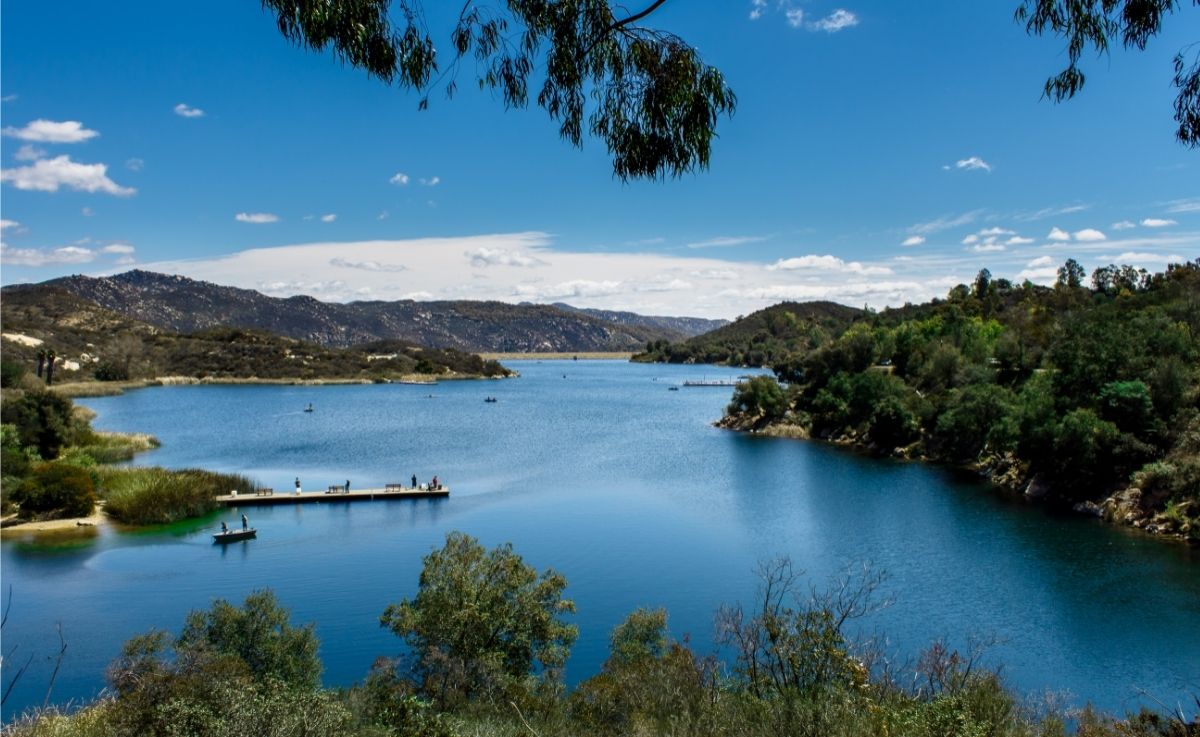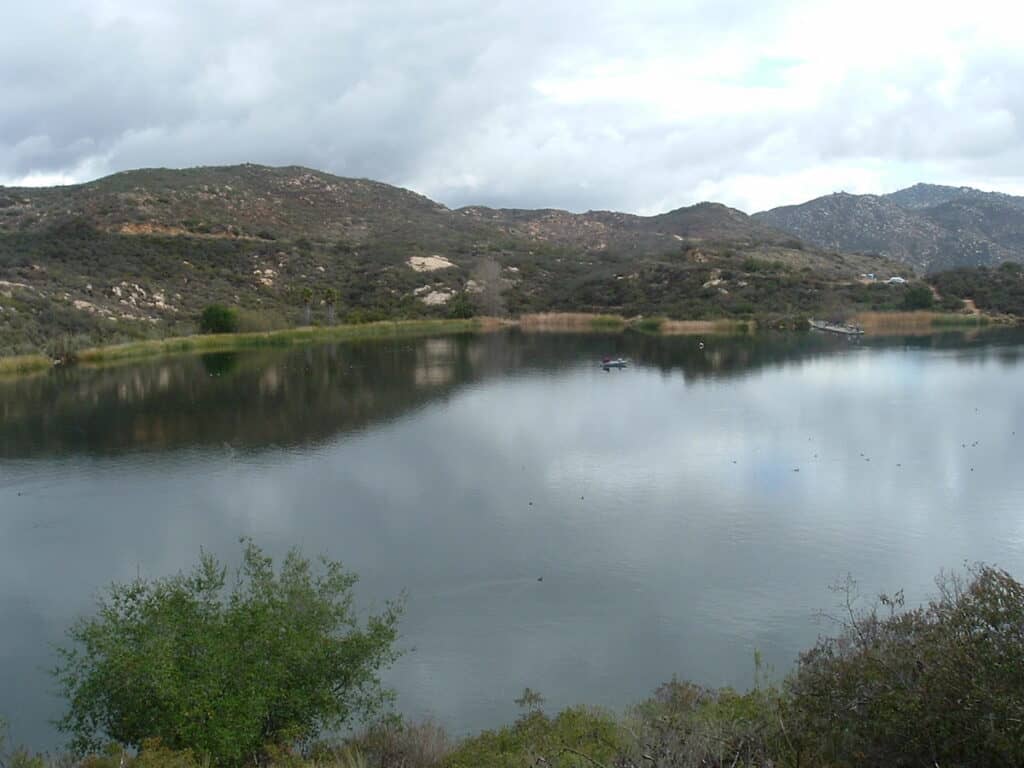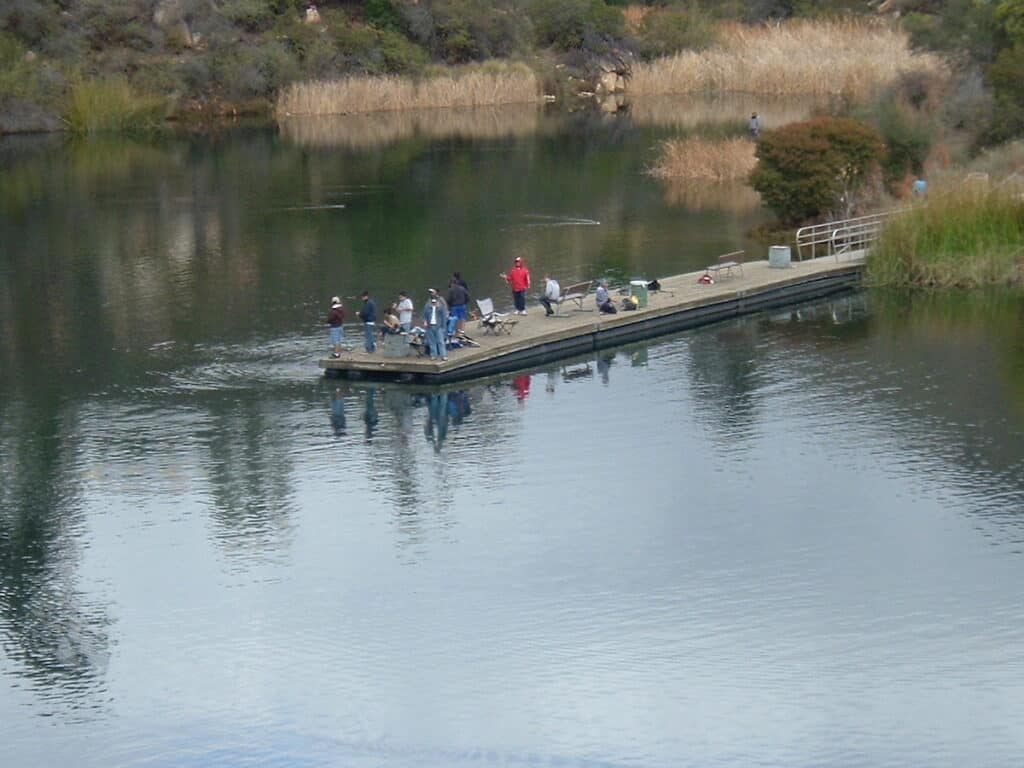Dixon Lake is famous for its fishing. Okay, to be more precise, Dixon Lake is renowned for one particular fish.
Back in 2001, while fishing for largemouth bass, an angler landed a fish that weighed 20 pounds, 11 ounces.
At the time, that was very close to the world record. Regardless of records, that is a giant bass. The fish had an easily identifiable dot on her chin, so she earned the name Dottie.
The bass was weighed and then released to fight another day. That day came in 2003 when another angler caught her. She had done a bit more growing over the previous few years and weighed in that time at 21 pounds, 11 ounces.
Again, she was returned to the water to fight another day.
She showed up again in 2006. Her weight had increased to an unheard of 25 pounds even. They took her weight at the dock’s official scale.
That weight would be the new world record by over 2 pounds, with an emphasis on ‘would.’ It turns out she was foul-hooked, meaning she not only didn’t count for the world record, but she also didn’t even count for the lake record.
Off she went back into the lake again.
Unfortunately, the staff working at Dixon Lake found Dottie floating dead in 2008. Thus ends the tale of the world’s (unofficial) biggest bass, though at last check she still held the fourth spot on the list for the 2003 catch.
Is there another largemouth hiding in Dixon Lake that could be even bigger, or was this a once-in-a-generation fish?
It couldn’t hurt to test your luck and see what you can catch. While the chances are slim that you’ll hook into a world record, you’ll probably catch something.
The main fish species targeted in Dixon Lake hasn’t changed over the years.
However, once just known for bass, it has also become an excellent catfish and trout fishery. Bass are still here and in decent numbers.
It could be that the bass got so big from eating all the planter trout and bluegill in the lake. Head over to Dixon Lake and see if you can catch Dottie’s great-grandchild.
Be sure to check current regulations before heading out.
Largemouth Bass Fishing
Largemouth bass are still readily found in Dixon Lake.
The chances of another Dottie being in there are probably slim, but you never know. Her genes live on in several more generations of bass, so maybe that will equate to bigger ones in the future.
Dixon Lake is a peculiar place. It’s a small lake compared to its neighbors. It’s narrow and runs about 80 feet deep when full. So why would it house such giant bucket mouths?
In the spring, you can find them in the shallows. The lake’s water is clear enough to allow sight fishing, so they are pretty easy to find.
Search around Trout Cove and off the points around Bass Point. The rocks there hold good, submerged cover.
Catfish Cove also is popular during the spawn, so try the shallower end, and you should do well.
When the summer water warms up, bass move deeper. The best spots to hit are Bass Point in 5 to 10 feet of water.
Drop-shot rigs with Roboworms, Texas rigs with Senkos, and Ned rigs with a Z-Man or a Robo Ned worm are likely to produce here.
Cooler water in the fall through mid-spring often find bass holding in 20 to 30 feet of water.
There also are times they will be very shallow.
For example, the few days following a trout stocking will find bass cruising the shallows filling up on rainbows. Anything rainbow trout colored will do great this time of year.
Oh, and just because nobody has caught another 25-pounder out of Dixon Lake, know that they have caught bass above 18 pounds, which for most anglers is still a once-in-lifetime fish. So keep searching!
Thanks more to the continued possibility of catching bass into the high teens than for the legend of Dottie, Dixon Lake remains one of the best largemouth bass fishing lakes in Southern California. Check out the full list.
Also, do you need to brush up on some fishing tips and techniques to catch more bass?
Rainbow Trout Fishing
It might seem obvious, but one of the best places on Dixon Lake to target larger trout is in Trout Cove. Boat Dock Cove is also productive.
In the cooler months, trout often spread throughout the lake and can be caught in the shallower bays and coves. Winter is a great time to shore fish for trout because they are often in reach, unlike the warmer months.
Stocking generally takes place from about October through April, and it stands to reason catches will be highest when there are lots of trout in the lake and cooler temperatures suit their needs.
An ultralight setup will do well because the stocked trout tend to be on the smaller side.
Standard trout techniques work well here, and when fishing after a planting has occurred, you might catch a big bass or two.
Be sure to check out the deeper portions of Whisker Bay. This area is known for excellent trout fishing when they are holding a bit deeper.
Nightcrawlers and PowerBait are good go-to baits to try. Try tube jigs tipped with worm here as well.
If you’re fishing in shallower water from the bank during warmer weather of late spring and summer, try to get on the water early in the morning and focus on the coves, where the trout may move into feed.
As the day progresses, trout move deeper and are tougher to catch.
Trolling techniques will put trout in the boat … if you’ve managed to rent one!
More About Trout
Best Rainbow Trout Fishing Lakes in California
Trout Fishing: How-to Techniques and Tips
Catfish Fishing at Dixon Lake
There are some real monster cats in Dixon Lake. Fish in the 30- to 40-pound range have been caught now and again.
A limit of catfish can be caught in Catfish Cove and Whisker Bay, sometimes in no time when the bite is hot. The buoy line is another great area during the summer months.
The best catfish hole in the lake is the aptly named Catfish. It is halfway across the lake from Bass Point. Head northeast of the point, and you’ll find it.
Fishing for cats warms up in the spring and stays good through late fall. Winter finds them a little more sluggish but still willing to eat if you can deliver some tasty bait close to them.
Load up a 1/0 or 2/0 baitholder with something stinky. Chicken liver, shrimp or cut mackerel are all go-to baits here.
Use a heavier rod and reel than you would for trout, with at least a 20-pound test, to have a better chance at landing one of the big ones.
You may catch your limit within an hour and have several over 10 pounds to show for it. Morning and evening fishing are best and might put your heavier tackle through its paces.
More: Find the Best Catfish Fishing Lakes and Rivers in California and also learn how to catch more (including best baits) with Catfish Fishing: Simple How-To Techniques and Tips.
Other Fish at Dixon Lake
Bluegill and crappie fishing can be good here.
Crappie tend to be harder to find but hold in some of the deeper cover near the docks.
Bluegill are well represented throughout the lake. There are many small fish in the lake but keep at it, and you could catch a few decent bluegill.
Mealworms and red worms will catch panfish pretty regularly, and small jigs are a good bet as well, especially when catching crappie.
Keep moving until you find a school and you’re in for some fun.
We know the answer: What are the very best crappie fishing lakes in California?
Planning your Trip
Dixon Lake, also known as Dixon Reservoir, is located in northeastern Escondido, just south of a large conservation area known as Daley Ranch.
The reservoir is about 40 miles from San Diego and only about a half hour’s drive inland from Carlsbad.
With the close location to large population centers including Orange County, you’d expect Dixon Lake to be crowded.
Yet with limited entry, it stays pretty calm. No swimming is allowed, so that also keeps most people besides anglers away from the water.
You don’t need a state fishing license but must purchase a Dixon Lake daily fishing permit on location, and they limit the number per day, so go early. There also is an additional entry fee charged on weekends and holidays.
Boat rentals are also available. At this writing, private boats may not be used at Dixon Lake. Plan ahead if you want one of the limited rental boats.
Be sure to check out the rules, fees and other details (including updates) at the city of Escondido’s Dixon Lake page.
Boat and Shore Access
Even if you don’t score a rental boat, shore access is readily available around most of the lake. Hiking trails will get you to the harder-to-reach areas and are worth checking out on their own merit.
Either way, there are great spots throughout the lake to catch big cats, bass and trout.
Lodging and Camping
Dixon Lake has a great campground. Be sure to reserve spots in advance.
They offer standard tent camping and RV spots with and without hookups and group sites.
Be aware that at last check, the city of Escondido was reporting an overabundance of raccoons. They will eat all your snacks and then take a flip-flop or a hat with them when they go. They make terrible dinner guests.
Hotels and restaurants are easy to get to and are close enough to the lake to make them a reasonable option. Check for rental properties in the area.
Hopefully, you’ll give Dixon Lake a try and catch the next record bass. If not, you’ll at least have fun!



